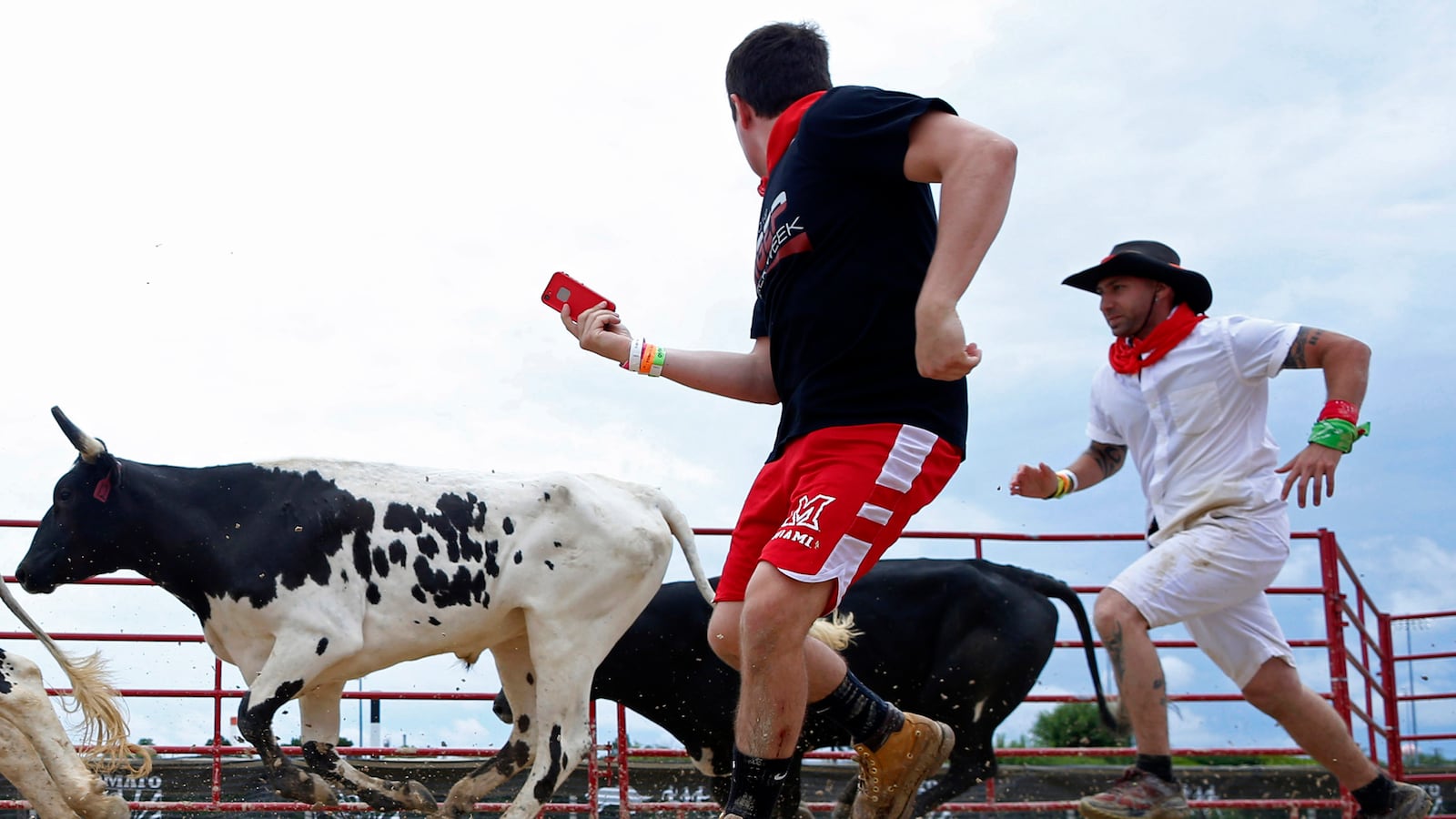Why would anyone deliberately get in the way of a 1,500-pound beast running at 35mph? Even more puzzling, why would they pay for the privilege? The long answer has to do with humanity’s psychological need to defy death, and the chemical rush that comes from doing so. The short answer, as any child knows, is that being scared is fun—even when it comes from a manufactured, largely illusionary sense of danger. That’s why we have roller-coasters. It’s why we watch horror. And it’s why thousands will flock to the Alameda County Fairgrounds this weekend to test themselves at the Great Bull Run.
This is an Americanized version of the famed Running with the Bulls festival in Pamplona, Spain. The Great Bull run, though, is a movable feast. Co-founders Rob Dickens and Brad Scudder are staging their GBR event in ten cities in this year. That includes where I went to test my own bull-running skills, earlier this month near Chicago—staged on the same day as the Pamplona festival began.
Dickens said he and Scudder, co-owners of a festival production company, got the idea after trying to arrange a last-minute visit to Pamplona of their own.
“We couldn’t make it happen” he said. “Everything gets booked a year in advance. Even if we could have gotten all the reservations, it would have been $4,000 a person. Plus you need to take about ten days off work.”
Scudder joked about bringing a version to the States.
“The more we looked,” Dickens said, “The more we realized it wasn’t that different from what we already do.”
This spring the pair went on ABC’s Shark Tank, and convinced Mark Cuban to invest $1.75 million in the venture, allowing for a major expansion this year—including the event near Chicago.
It had rained all night and was still drizzling when I headed for the Hawthorne Race Course in suburban Cicero, Illinois. In the car on the way, there was a story on the radio of a goring in Pamplona. The guy who actually wrote the book on running with the bulls had been seriously injured. Not a great portent. The place was decked with red and black banners. Pop music was blaring. Vendors in white tents lined the fan concourse, selling food, beer and merch. There was an inflatable bouncy house for kids and a thematically appropriate mechanical bull ride for grown-ups.
The run itself was on the racecourse. All Great Bull Runs are held on equestrian-friendly surfaces to make for softer landings. That’s one reason why the GBR is safer than Pamplona, where they run on cobblestone streets. Another safety feature is the fence. The homestretch of the track had been blocked off with cattle fencing—the kind they use at rodeos that makes for easy climbing.
The rain stopped past noon just as the first group of about 300 fans was let in. The track was muddy. This would make for messy, but even softer landings. Almost too soft, which I’d discover later in the day.
The runners were rowdy, some had been drinking. About 80% were male, most under 40. On the way in, we were all given red bandannas—a nod to the traditional runner’s garb in Pamplona. But most of us were already festively dressed, in wigs, silly hats, superhero costumes, or white t-shirts with red targets painted crudely on back. Cameras were everywhere. GoPros were common, strapped to heads and chests. A few participants, as I’d soon see, would run holding their phones in front of them, trying to get a selfie with the charging bulls in the background. The mind reels.
Dickens stood on a small stage holding a microphone. I literally sat on the fence, deciding if I wanted to run. Dickens greeted the crowd, gave a few tips and instructions, then led us in a countdown from ten to one. At his signal, a gate at the far end of the enclosure was swung open. Two wranglers on horseback chased 20 bulls from a holding pen.
At first, I could only see people running, yelling and jostling. Then the bulls rumbled past, humans fleeing before them or jumping out of the way. The bulls came in groups of three or four, followed by an occasional straggler. The beasts are huge, hulking, fast and unpredictable—tons of muscle, horn and thundering hooves. The sheer proximity to force was a thrill.
The bulls ran through the crowd, and into another pen at the opposite end of the enclosure. It was all over in under two minutes. That didn’t stop most fans I talked to, who had paid at least $50 bucks a head to run, from loudly declaring themselves satisfied.
By the third run my testosterone kicked in. I’d started to feel silly only watching. It was time to get my Hemingway on.
Even inside the pen it was relatively easy to stay out of harm’s way. The first run, I just clung to the fence as the bulls passed. Technically, though, that was “standing with the bulls” To really get the full effect, you need to have a running start as the bulls approach and try to keep up for a few paces. Which I did, finally, on the day’s fifth run. For a few steps, I kept even with a group of three bulls, close enough to touch cowhide. I didn’t, although a lot of runners slapped a bull flank as they passed to take a kind of tactile trophy.
It was fantastic. The biggest misconception people have about bulls, Dickens told me, is that they want to attack humans. They don’t. Not when they’re in groups, and the herd mentality rules. All they want is to run. The big danger then is getting tripped or knocked down by other runners. That’s when you might get stuck underneath a barrage of pounding hoofs. But when a bull gets separated from the pack and feels threatened, that’s when there’s real trouble. That’s when they can feel threatened, and might try to gore you, or fling you aside with their massive skulls and broad horns.
Still, dangerous as it seems, you aren’t really likely to get hurt. At least not badly. Out of about 3,000 runners in Chicago, only two minor injuries were reported. One guy took a horn in the thigh, suffering a baseball-sized contusion. Another was hit from behind and got whiplash.
There have been more serious injuries, though. At the Great Bull Run in Virgina someone broke a wrist. One runner in Houston now has a permanent, hoof-shaped scar in the center of his forehead. A guy in Atlanta shattered his pelvis. Generally though, it’s probably more dangerous to text and drive.
Texting and driving, however, doesn’t feel scary. Getting close to a bunch of giant, angry, fast-moving wild animals does. It’s a primal and visceral fear. That’s the point. The Great Bull Run is less about being in danger than feeling like you are.
Which I did—for a instant—on the final run of the day.
A wave of four bulls passed with me managing to keep pace for a step or two. Then I slowed. The guy behind me did not. Our feet got tangled, and we both tumbled into the mud. When I looked up, there was a single bull coming—a truckload of muscle running straight for us, closing fast and looking pissed. His eyes meet mine. For just a moment, I froze and found myself imagining what it would feel like to break a pelvis.
Dickens, in his pre-run address, said that bulls usually jump over obstacles in their path. If we fall, he said, we should stay down. But doing a duck-and-cover while there’s 1,500 pounds of beef bearing down on you is antithetical to the human spirit. I scrambled toward the fence, loosing footing for an instant, then jumped to one of the rails halfway up. My muddy shoe slipped, and I banged my kneecap on a fence rail, clinging for dear life. The bull, apparently having decided that goring me wasn’t worth the effort, passed close enough for me to feel the rush of air.
It was, at best, a few seconds of true fear. But it was enough. My heart was pounding, skin flush, senses heightened. Everyone around me seemed to be smiling with their eyes aglow.
Granted, there was something fundamentally contrived about the experience—and not only because I was in Chicago instead of Spain. Whether it’s bulls or bungee jumping, the quest for manufactured fear is a uniquely First World pursuit—a need created by the strange ennui and sensory deprivation of our affluent, but sedentary and insulated lives. Someone who lives in a war zone, for instance, would probably be a lot less likely to pay for the sensation of fearing death. They’d probably pay not to have it.
Still, manufactured or not, there is an element of fear that makes life more worth living. As philosopher Ernest Becker wrote “To live fully is to live with an awareness of the rumble of terror that underlies everything.” Becker, though, probably meant an existential rumble. At the Great Bull Run, that rumble was real.





